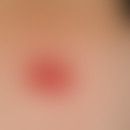Synonym(s)
HistoryThis section has been translated automatically.
DefinitionThis section has been translated automatically.
Rare, congenital or up to 30 years of age, clinically very variable genodermatosis associated with extensive erythema.
You might also be interested in
EtiopathogenesisThis section has been translated automatically.
Mutations of the GJB3 and GJB4 genes (encoding the gap junction connexins beta 3 and beta 4) have been shown to cause expression of defective connexins and thus impaired intercellular contacts. There is autosomal dominant inheritance with almost complete penetrance and intrafamilial variability.
Furthermore, "de novo missense mutations" of the GJA1 gene(gap junction protein alpha 1) have been detected. GJA1 encodes connexin 43 (Cx43), an important gap junction protein.
ManifestationThis section has been translated automatically.
Often already present at birth or manifesting in the first year of life. Rarely do the first skin changes occur in childhood or early adulthood.
LocalizationThis section has been translated automatically.
Predilection sites are the face, the extremities and the buttock region. No preference for the extensor or flexor sides. Palms and soles of the feet are also affected in 50% of cases. Hair and nails are inconspicuous.
ClinicThis section has been translated automatically.
Migrating (variable = variabilis), bizarrely configured, anular or polycyclic scaly papules and plaques with varying clinical expressivity and acuteity. Initially flat, red papules with slow, centrifugal growth are found. Urticarial or multiforme HV are also possible.
Older foci present as large red or reddish-brown plaques, mostly borderline. Central healing is possible, so that anular and by confluence polycyclic patterns can develop. Often peripheral, coarse-lamellar scaly ruffs. There are also locally fixed (e.g. knees), less reddened keratotic plaques (pressure-exposed areas). The majority of patients develop a pronounced palmoplantar keratosis.
The skin changes are usually less symptomatic, itching and even burning are possible.
Typically, a deterioration of the skin condition is indicated by heat.
HistologyThis section has been translated automatically.
Orthohyperkeratosis with focal parakeratosis in acanthosis and papillomatosis; isolated dyskeratotic keratinocytes. Accompanying mild perivascular oriented lymphocytic infiltrates are found. No epidermotropia.
Differential diagnosisThis section has been translated automatically.
External therapyThis section has been translated automatically.
Internal therapyThis section has been translated automatically.
Progression/forecastThis section has been translated automatically.
LiteratureThis section has been translated automatically.
- Boyden LM et al (2014) Dominant De Novo Mutations in GJA1 Cause Erythrokeratodermia variabilis et progressiva, without Features of Oculodentodigital Dysplasia. J Invest Dermatol doi: 10.1038/jid.2014.485.
- de Buy Wenninger LM (1907) Erythrokeratodermie congenitale ichthyosiforme avec hyperepidermotrophie. in Verslagen van vereeningingene. Nederl Tijdschr Geneesk 1A: 510-515.
- Itin P et al (1992) Family history of erythrokeratoderma figurata variabilis. Dermatologist 43: 500-504
- Mendes da Costa S (1925) Eythro- et keratodermia variabilis in a mother and a daughter. Acta Derm Venerol 6: 255-261
- Otaguchi R et al.(2014) A sporadic elder case of erythrokeratodermia variabilis with a
- single base-pair transversion in GJB3 gene successfully treated with systemic vitamin A derivative. J Dermatol 41:1016-1018.
- Rappaport JP et al (1986) Erythrokeratodermia variabilis treated with isotretinoin: A clinical, histological and ultrastructural study. Arch Dermatol 122: 441
- Richard G et al (1998) Mutations in the human connexin gene GJB3 cause erythrokeratoderma variabilis. Nat Genet 20: 366-369
- Richard G et al (2003) Genetic heterogeneity in erythrokeratodermia variabilis: Novel mutations in the connexin gene GJB4 (Cx30.3) and genotype-phenotype correlations. J Invest Dermatol 120: 601-609
- Salamon T et al (1985) A case of erythrokeratoderma variabilis. Dermatologist 36: 522-525
Incoming links (12)
Connexine; Da costa syndrome; Erythème desquamative en plaque congénital et familial; Erythrokeratodermia progressive symmetrica; Gap junctions; GJA1 Gene; GJB3 Gene; Keratodermia figurata variabilis; Mendes da costa syndrome; Pityriasis rubra pilaris (adult type); ... Show allOutgoing links (16)
Acitretin; Connexine; Epidermolytic ichthyosis; Erythrokeratodermia progressive symmetrica; Gap junctions; GJA1 Gene; GJB3 Gene; GJB4 Gene; Glucorticosteroids topical; Keratolytics; ... Show allDisclaimer
Please ask your physician for a reliable diagnosis. This website is only meant as a reference.







